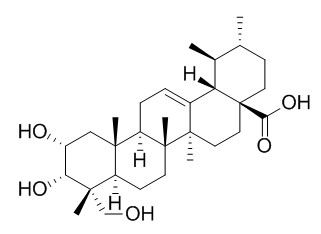Esculentic acid
Esculentic acid has anti-inflammatory effect, it has protective effects against LPS-induced endotoxic shock may be mediated, at least in part, by regulation the release of inflammatory cytokines and mediators, and protein expression of COX-2 in mice.
Inquire / Order:
manager@chemfaces.com
Technical Inquiries:
service@chemfaces.com
Tel:
+86-27-84237783
Fax:
+86-27-84254680
Address:
1 Building, No. 83, CheCheng Rd., Wuhan Economic and Technological Development Zone, Wuhan, Hubei 430056, PRC
Providing storage is as stated on the product vial and the vial is kept tightly sealed, the product can be stored for up to
24 months(2-8C).
Wherever possible, you should prepare and use solutions on the same day. However, if you need to make up stock solutions in advance, we recommend that you store the solution as aliquots in tightly sealed vials at -20C. Generally, these will be useable for up to two weeks. Before use, and prior to opening the vial we recommend that you allow your product to equilibrate to room temperature for at least 1 hour.
Need more advice on solubility, usage and handling? Please email to: service@chemfaces.com
The packaging of the product may have turned upside down during transportation, resulting in the natural compounds adhering to the neck or cap of the vial. take the vial out of its packaging and gently shake to let the compounds fall to the bottom of the vial. for liquid products, centrifuge at 200-500 RPM to gather the liquid at the bottom of the vial. try to avoid loss or contamination during handling.
In Vivo.2022, 36(3):1136-1143.
mBio.2020, 11(3):e00686-20.
Biomol Ther (Seoul).2024, 32(2):214-223.
Biochem Biophys Res Commun.2020, 530(1):4-9.
Int J Mol Sci.2024, 25(12):6456.
Asian J Beauty Cosmetol2019, 17(3):287-294
Appl Microbiol Biotechnol.2024, 108(1):207.
Cell Mol Biol(Noisy-le-grand)2019, 65(7):77-83
Histol Histopathol.2022, 18518.
Molecules.2022, 27(21):7514.
Related and Featured Products
Int Immunopharmacol. 2014 Nov;23(1):229-35.
Protective effects of esculentic acid against endotoxic shock in Kunming mice.[Pubmed:
25242384]
Esculentic acid (EA), a triterpene compound extracted from the root of Phytolacca esculenta (the Chinese name Shang Lu), has been widely used to therapy a variety of inflammatory diseases such as rheumatoid arthritis, edema, hepatitis and bronchitis.
METHODS AND RESULTS:
The present study was designed to investigate the protective effects of EA against LPS-induced endotoxic shock by the intraperitoneal injection of EA (1, 5 and 10 mg/kg) prior to LPS stimulation (1 mg/kg, i.p.). We examined the effects of EA on the survival rate of mice, inflammatory cytokine and pro-inflammatory mediator production, histopathological changes and protein expression of COX-2 in tissue sections from lung, liver and kidney. The results indicate that EA not only increases the survival rate of mice, but decreases the levels of TNF-α, IL-6, NO and PGE2 in serum or tissues, histopathological changes and COX-2 protein expression also. Furthermore, EA also increases the levels of anti-inflammatory cytokine IL-10 in serum.
CONCLUSIONS:
Overall, these data suggest that the protective effects of EA against LPS-induced endotoxic shock may be mediated, at least in part, by regulation the release of inflammatory cytokines and mediators, and protein expression of COX-2 in mice.
Eur J Pharmacol. 2014 Oct 5;740:532-8.
Esculentic acid, a novel and selective COX-2 inhibitor with anti-inflammatory effect in vivo and in vitro.[Pubmed:
24991788]
Esculentic acid (EA), a pentacyclic triterpenoids compound extracted from the Chinese herb Phytolacca esculenta, has long been used in traditional Chinese medicine for the treatment of rheumatoid arthritis, edema, hepatitis and bronchitis disease. The present study aimed to investigate the anti-inflammatory effect of EA in vivo and in vitro and the effect of EA on cyclooxygenase (COX) protein expression.
METHODS AND RESULTS:
To gain insight into the anti-inflammatory effect of EA both in vivo and in vitro and its effect on COX-2 expression, we used animal inflammatory models and lipopolysaccharide (LPS)-induced mouse peritoneal macrophages to examine the anti-inflammatory action of EA. Our findings demonstrated that EA possessed potent anti-inflammatory activity both in vivo and in vitro, while the anti-inflammation action in vitro may be attributed to the inhibition of the level of TNF-α and IL-6 pro-inflammatory cytokines and PGE2 inflammatory mediator in macrophages. Meanwhile, the production of PGE2 was possibly associated with COX-2 protein expression which was similar to that of NSAIDS.
CONCLUSIONS:
The study extends our understanding of the anti-inflammatory effect of EA both in vivo and in vitro and provides clarification of the molecular mechanisms underlying the effect of EA on PGE2 production, extending a novel aspect to the pharmacological activity of EA.



